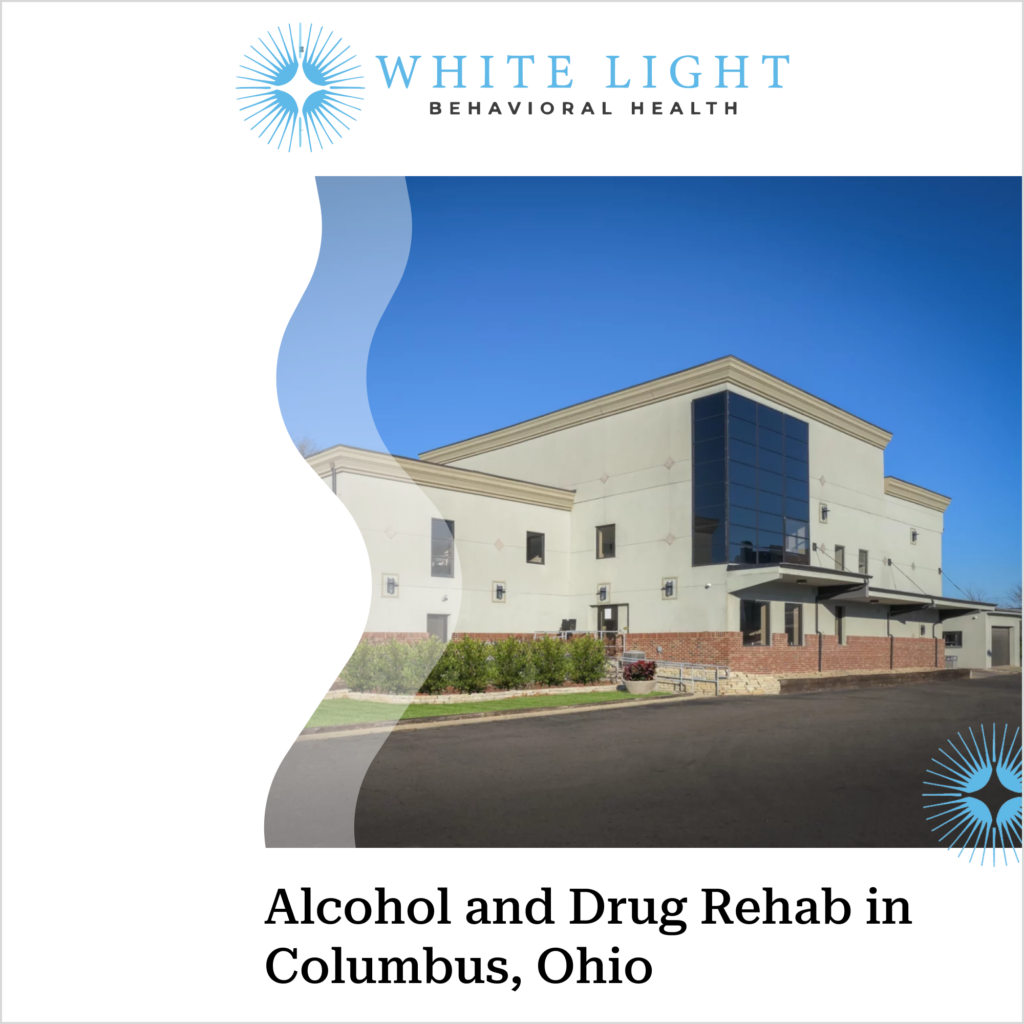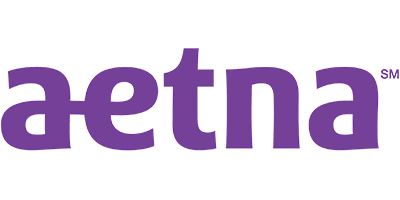Dialectical Behavior Therapy (DBT): Definition, Application, Technique, And Worksheets
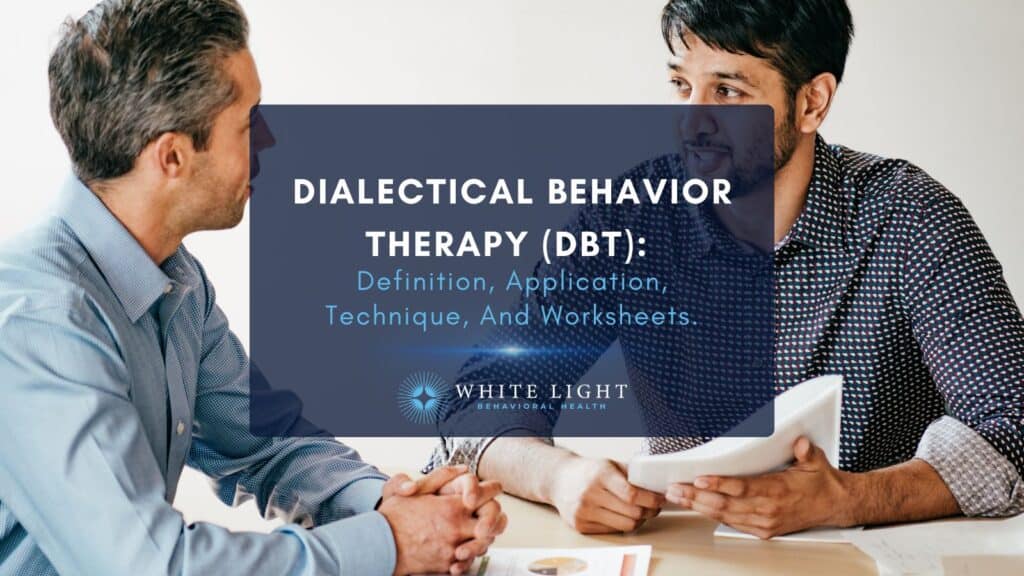
Dialectical Behavior Therapy (DBT) gives you tools to manage emotional overwhelm, impulsive behavior, and strained relationships. If you’re searching for lasting ways to control emotions and reduce chaos in daily life, DBT offers a practical, evidence-driven approach.
According to the Ohio Department of Mental Health and Addiction Services (2023), usage of DBT-based programs in Franklin County increased by 41% over the past five years, especially among adults seeking alternatives to crisis intervention or medication alone.
You can start DBT through local providers, such as White Light Behavioral Health, or nonprofit centers. Both offer in-person and online DBT in Columbus with flexible schedules, insurance support, and full-program formats.
What Is Dialectical Behavior Therapy (DBT)?
Dialectical Behavior Therapy (DBT) is a structured, evidence-based treatment that combines cognitive-behavioral therapy with mindfulness practices to help you manage overwhelming emotions and improve behavioral control. Developed by Dr. Marsha Linehan, DBT was originally created for individuals dealing with chronic emotional dysregulation and borderline personality disorder.
It’s now widely used for treating PTSD, ADHD, self-harming behaviors, and patterns of emotional instability. DBT’s core strategy is to balance acceptance and change, helping you recognize emotional responses while building real-world coping skills to replace harmful patterns.
Suppose you’re searching for “DBT therapy for emotional regulation” or “Columbus, Ohio DBT therapist for ADHD or PTSD”. In that case, you’ll find that local programs increasingly offer these techniques through both individual sessions and group skills classes.
Did you know most health insurance plans cover substance use disorder treatment? Check your coverage online now.
What’s The Difference Between Full DBT and DBT-Informed Therapy?
The difference between full DBT and DBT-informed therapy lies in structure, intensity, and adherence to the original treatment model.
Full DBT includes four core components: individual therapy, weekly group skills training, 24/7 phone coaching, and therapist team consultation. This model is ideal if you’re facing chronic emotional distress, self-harming behaviors, or borderline personality disorder.
In contrast, DBT-informed therapy uses selected DBT tools like mindfulness or distress tolerance without the full protocol. Therapists incorporate DBT strategies into sessions, but without offering all four treatment pillars.
Full DBT is recommended when symptom severity interferes with daily life or safety. DBT-informed options work better for specific skills-building or supplemental support.
More Resources on Addiction:
Do I Need A Diagnosis To Enroll In DBT?
Yes, most DBT programs begin with an initial evaluation to determine whether the therapy aligns with your needs. While you don’t always need a formal diagnosis to participate, having one, such as borderline personality disorder (BPD), PTSD, or chronic emotional dysregulation, impacts eligibility for insurance coverage.
Programs offering DBT therapy in Columbus, Ohio, require a clinical intake to assess your emotional symptoms, risk factors, and treatment goals. If you plan to use insurance, a diagnosis is required for reimbursement. Medicaid and private plans cover DBT for BPD, self-harming behaviors, and trauma-related issues.
What Are The Four Core Modules Of DBT?
The core modules of Dialectical Behavior Therapy (DBT) are mindfulness, distress tolerance, emotion regulation, and interpersonal effectiveness. They are designed to help you manage overwhelming emotions, navigate relationships, and reduce impulsive behavior.
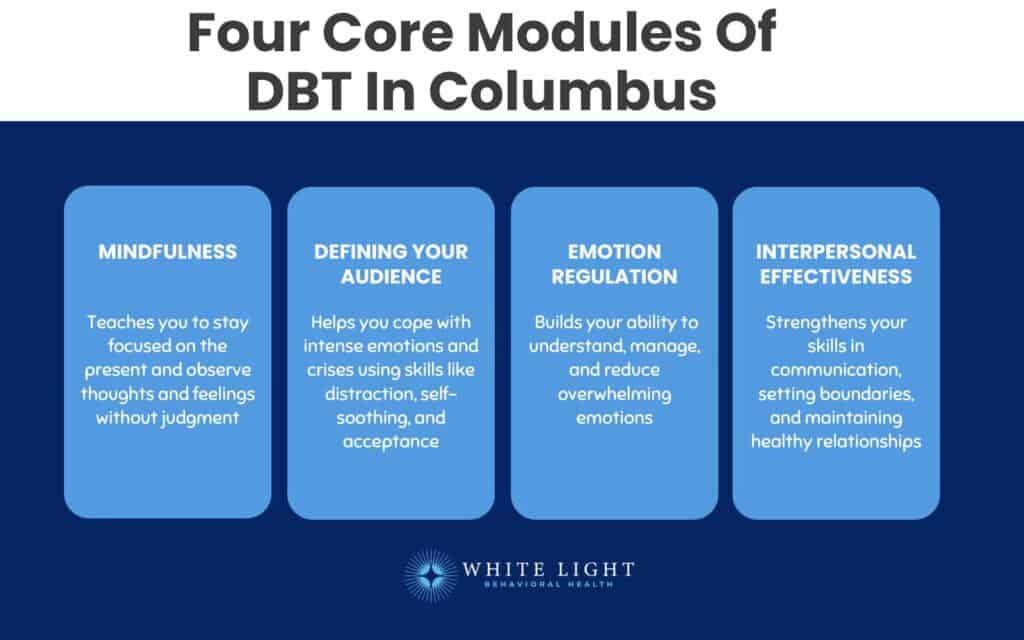
The core modules of Dialectical Behavior Therapy (DBT) are:
- Mindfulness: Mindfulness helps you stay grounded in the present moment. It teaches you how to observe thoughts and feelings without judgment, allowing you to respond with clarity instead of reactivity.
- Distress Tolerance: This module provides tools to survive emotional crises without making things worse.
You learn skills like distraction, self-soothing, and radical acceptance during periods of high stress.
- Emotion Regulation: You build skills to identify emotional patterns and reduce emotional intensity. This includes tracking emotions, reducing vulnerability, and increasing positive emotional events.
- Interpersonal Effectiveness: This area focuses on helping you communicate clearly, set boundaries, and preserve relationships.
It’s especially useful for managing conflict and asking for what you need without aggression or withdrawal.
What Is The Structure Of A Standard DBT program?
The Structure Of A Standard DBT Program includes Individual therapy, skills group training, phone coaching, and a therapist consultation team. This structured format is designed to target both emotional stability and behavioral change.
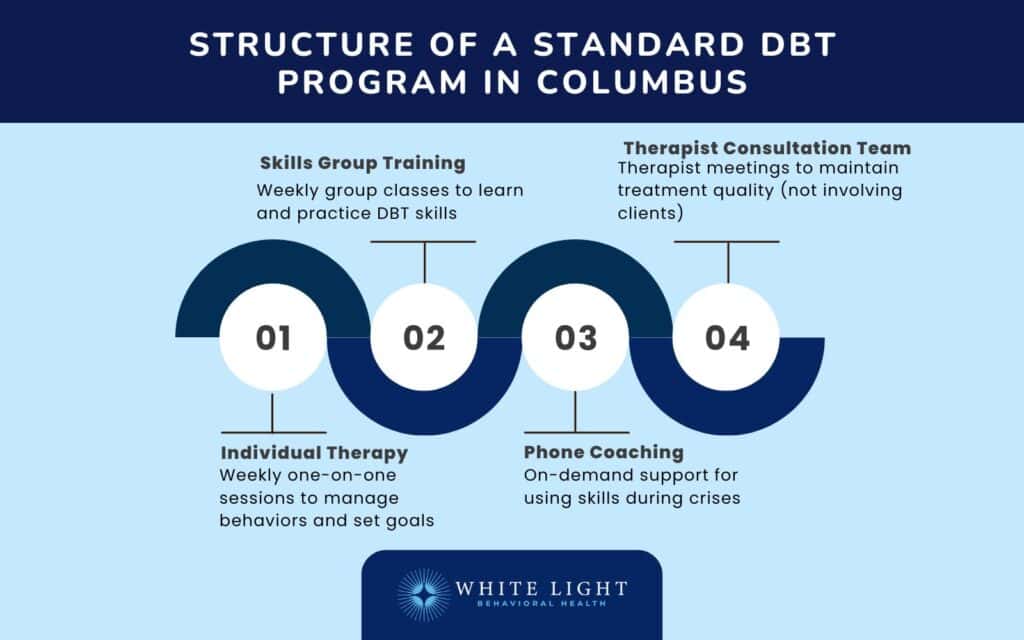
The structure of a standard DBT program is explained below:
- Individual Therapy (Once Weekly): You meet one-on-one with a trained DBT therapist to apply skills to your personal life. These sessions focus on managing high-risk behaviors and setting weekly behavioral goals.
- Skills Group Training (Once Weekly): You attend a 1.5–2 hour group session to learn and practice the four DBT skill modules.
These sessions are educational, rather than group therapy, and follow a workbook-based format.
- Phone Coaching: You receive brief, real-time coaching between sessions. This helps you apply DBT skills during emotional crises or interpersonal conflicts.
- Therapist Consultation Team (Internal): Your therapist meets regularly with a consultation team to ensure the quality and consistency of care.
Although not client-facing, this component ensures your treatment remains aligned and effective.
What Are Signs That DBT Is Working For Me?
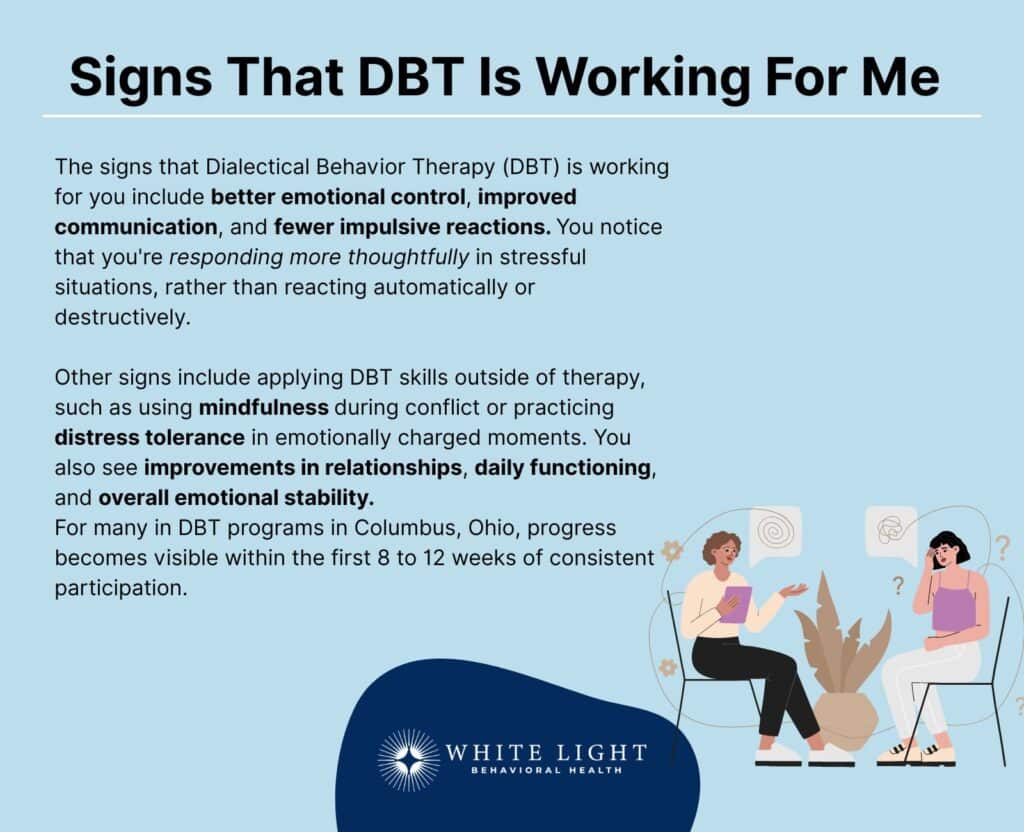
The signs that Dialectical Behavior Therapy (DBT) is working for you include better emotional control, improved communication, and fewer impulsive reactions. You notice that you’re responding more thoughtfully in stressful situations, rather than reacting automatically or destructively.
Other signs include applying DBT skills outside of therapy, such as using mindfulness during conflict or practicing distress tolerance in emotionally charged moments. You also see improvements in relationships, daily functioning, and overall emotional stability.
For many in DBT programs in Columbus, Ohio, progress becomes visible within the first 8 to 12 weeks of consistent participation.
Contact us today to schedule an initial assessment or to learn more about our services. Whether you are seeking intensive outpatient care or simply need guidance on your mental health journey, we are here to help.
Where Is DBT Offered In Columbus, Ohio?
You can find DBT programs in Columbus, Ohio, through both private practices and nonprofit mental health organizations. Clinics offer full or DBT-informed services, including individual therapy, skills groups, and phone coaching. Availability varies, but many programs serve adults, teens, and families with flexible scheduling. Services are offered in-person and online, depending on the provider.
White Light Behavioral Health, a Columbus-based treatment center, offers comprehensive DBT services for emotional regulation, trauma, and behavioral concerns. Their program includes all four DBT components and follows a structured, evidence-based model.
Can You Access DBT Online In Columbus?
Yes, you can access DBT online in Columbus, Ohio, through multiple local providers offering telehealth services. Many clinics provide virtual individual therapy and skills training sessions using secure, HIPAA-compliant platforms.
Online DBT gives you access to full programming from home, making it easier to maintain consistency if you have transportation issues, health concerns, or scheduling constraints.
Can I Practice DBT While Working or Attending School Full-Time?
Yes, you can practice DBT while working or attending school full-time. Many programs in Columbus, Ohio, offer evening or weekend group sessions to fit around your schedule. Individual therapy sessions are booked early in the morning, during lunch hours, or virtually, giving you flexibility without sacrificing consistency.
What DBT Worksheets Are Commonly Used In Therapy?
The DBT worksheets commonly used in therapy are diary cards, chain analysis worksheets, emotion regulation logs, distress tolerance tools, and interpersonal effectiveness forms. These tools reinforce what you learn in sessions and support real-world application of DBT skills.
The DBT worksheets commonly used in therapy are:
- Diary Cards to monitor emotions, urges, and skill use daily
- Chain Analysis Worksheets to examine triggers, behaviors, and consequences
- Emotion Regulation Logs to identify and label emotional responses
- Distress Tolerance Tools like TIPP and ACCEPTS exercise sheets
- Interpersonal Effectiveness Forms for setting boundaries and practicing assertive communication
How Long Does A DBT Program Last?
The standard DBT program lasts between 6 and 12 months. The duration depends on your treatment goals and the severity of symptoms. You complete one full cycle of skills training in 24 weeks, followed by a second cycle for deeper integration.
In Columbus, Ohio, providers like White Light Behavioral Health and Southeast Healthcare structure their programs around weekly sessions, with options to continue as needed. Some individuals complete DBT in under a year, while others remain in maintenance therapy to reinforce progress.
Rediscover Life at White Light Behavioral Health
Get the compassionate support you deserve. We're here to help you reclaim joy, wellness, and a brighter future.
Our Facility
How is DBT different from Cognitive Behavioral Therapy (CBT)?
DBT is different from CBT in that it combines cognitive-behavioral techniques with mindfulness and acceptance strategies, placing a stronger emphasis on regulating intense emotions and improving interpersonal relationships. While CBT focuses primarily on identifying and changing negative thought patterns, DBT helps individuals balance change with self-acceptance, making it especially effective for conditions like borderline personality disorder, chronic self-harm, and emotional dysregulation. Cognitive Behavioral Therapy (CBT), by contrast, is more structured and goal-oriented, targeting distorted thinking and maladaptive behaviors through practical problem-solving and skill-building techniques.
Share This Post
